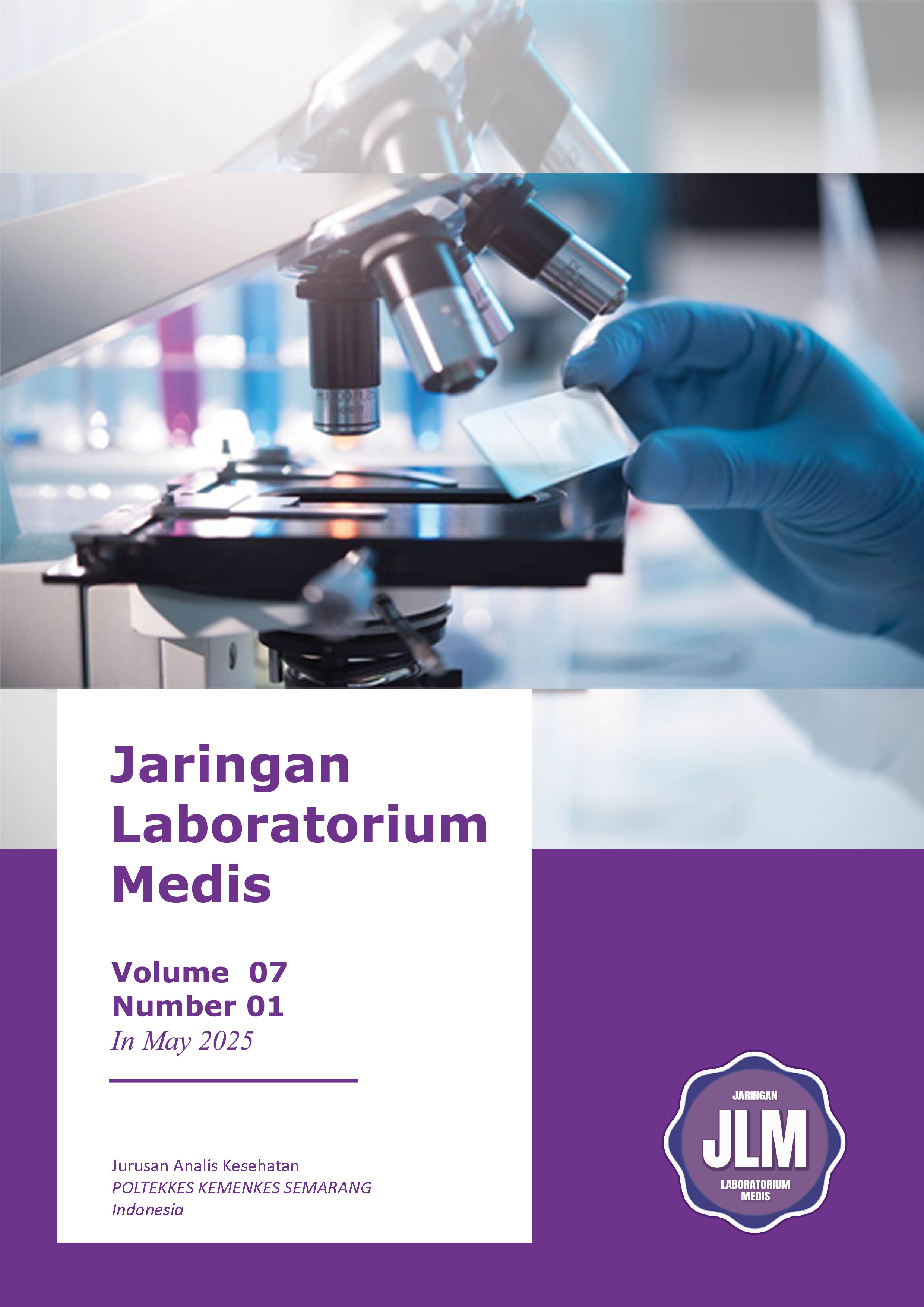The relationship between Erythrocyte Sedimentation Rate examination and Rapid Tuberculosis IgG/IgM Test
Published 2025-05-01
Keywords
- Erythrocyte Sedimentation Rate,
- Tuberculosis IgG/IgM
Copyright (c) 2025 Jaringan Laboratorium Medis

This work is licensed under a Creative Commons Attribution-ShareAlike 4.0 International License.
How to Cite
CrossMark
Dimensions
If it doesn't Appear, click here
Impact Factor
Abstract
Mycobacterium tuberculosis is an acid-fast bacteria that causes pulmonary tuberculosis (TB) is an infectious disease that is a priority health problem in developing countries including Indonesia. Fast and accurate examination is very important in diagnosing tuberculosis. Tuberculosis examination has several methods that are not commonly applied, namely the Immunochromatography test (ICT) examination. This study is a non-experimental study with a survey method without intervention that is descriptive analytical. The purpose of the study was to see the relationship between the examination of the Erythrocyte Sedimentation Rate and the Rapid Tuberculosis IgG / IgM Test. The results obtained that the LED results of 8 samples were normal and 17 samples were abnormal, while the ICT test for IgG examination of all samples was negative, IgM 24 samples were negative and 1 sample was positive. The results of the Chi square statistical test obtained an α value of 0.618 so that it can be concluded that there is no relationship between the LED value and the results of the IgG and IgM tuberculosis tests.
Downloads
References
- Alfia, S. et al. (2023). “Phosphate Buffer Saline As an Alternative Diluent in Examination of Erythrocyte Sedimentation Rate Westergreen Method,” Meditory : The Journal of Medical Laboratory, 11(2), hal. 142–146. doi:10.33992/meditory.v11i2.2817.
- Harta Wedari, N.L.P. et al. (2021). “Tuberculosis cases comparison in developed country (Australia) and developing country (Indonesia): a comprehensive review from clinical, epidemiological, and microbiological aspects,” Intisari Sains Medis, 12(2), hal. 421. doi:10.15562/ism.v12i2.1034.
- Higuchi, M. dan Watanabe, N. (2023). “Determination of the erythrocyte sedimentation rate using the hematocrit-corrected aggregation index and mean corpuscular volume,” Journal of Clinical Laboratory Analysis, 37(6), hal. 1–8. doi:10.1002/jcla.24877.
- Kahar, M.A. (2022). “Erythrocyte Sedimentation Rate (with its inherent limitations) Remains a Useful Investigation in Contemporary Clinical Practice,” Annals of Pathology and Laboratory Medicine, 9(6), hal. R9-17. doi:10.21276/apalm.3155.
- Kemenkes RI (2020). “Strategi Nasional Penanggulangan Tuberkulosis di Indonesia 2020-2024,” Pertemuan Konsolidasi Nasional Penyusunan STRANAS TB, hal. 135.
- Kemenkes RI (2023). “Ditjen P2P Laporan Kinerja Semester I Tahun 2023,” hal. 1–134.
- Magalhães, J.L. de O. et al. (2018). “Microscopic detection of mycobacterium tuberculosis in direct or processed sputum smears,” Revista da Sociedade Brasileira de Medicina Tropical, 51(2), hal. 237–239. doi:10.1590/0037-8682-0238-2017.
- Mukherjee, S. et al. (2020). “Since January 2020 Elsevier has created a COVID-19 resource centre with free information in English and Mandarin on the novel coronavirus COVID- 19 . The COVID-19 resource centre is hosted on Elsevier Connect , the company ’ s public news and information,” Elsevier, 140(January), hal. 1–21. Tersedia pada: https://www.ncbi.nlm.nih.gov/pmc/articles/PMC10072981/pdf/main.pdf.
- Nurjana, M.A. et al. (2020). “The Relationship between External and Internal Risk Factors with Pulmonary Tuberculosis in Children Aged 0-59 Months in Slums in Indonesia, 2013,” Global Journal of Health Science, 12(11), hal. 116. doi:10.5539/gjhs.v12n11p116.
- Rahmat Ullah, S. et al. (2021). “Immunoinformatics Driven Prediction of Multiepitopic Vaccine Against Klebsiella pneumoniae and Mycobacterium tuberculosis Coinfection and Its Validation via In Silico Expression,” International Journal of Peptide Research and Therapeutics, 27(2), hal. 987–999. doi:10.1007/s10989-020-10144-1.
- Remesar, X. dan Alemany, M. (2020). “Dietary energy partition: The central role of glucose,” International Journal of Molecular Sciences, 21(20), hal. 1–38. doi:10.3390/ijms21207729.
- Sirin, F.B. et al. (2021). “Evaluation of the Vision C erythrocyte sedimentation rate analyzer,” International Journal of Medical Biochemistry, 4(3), hal. 172–177. doi:10.14744/ijmb.2021.52244.
- Sorsa, A. (2020). “The diagnostic performance of chest-x-ray and erythrocyte sedimentation rate in comparison with genexpert® for tuberculosis case notification among patients living with human immunodeficiency virus in a resource-limited setting: A cross-sectional study,” Risk Management and Healthcare Policy, 13, hal. 1639–1646. doi:10.2147/RMHP.S264447.
- Steingart, K.R. et al. (2014). “Xpert® MTB/RIF assay for pulmonary tuberculosis and rifampicin resistance in adults,” Cochrane Database of Systematic Reviews, 2014(1). doi:10.1002/14651858.CD009593.pub3.
- Tomassetti, F. et al. (2024). “Performance Evaluation of Automated Erythrocyte Sedimentation Rate (ESR) Analyzers in a Multicentric Study,” Diagnostics, 14(18), hal. 1–12. doi:10.3390/diagnostics14182011.
- Widodo et al., 2025 (2025). “Regional Variations in rpoB Gene Mutations and Their Association with Rifampicin Resistance in Mycobacterium tuberculosis,” hal. 137–144. doi:https://doi.org/10.20884/1.jm.2025.20.1.13215.
- Widodo, W., Irianto, A. dan Pramono, H. (2017). “Karakteristik Morfologi Mycobacterium tuberculosis yang Terpapar Obat Anti TB Isoniazid (INH) secara Morfologi,” Biosfera, 33(3), hal. 109. doi:10.20884/1.mib.2016.33.3.316.

